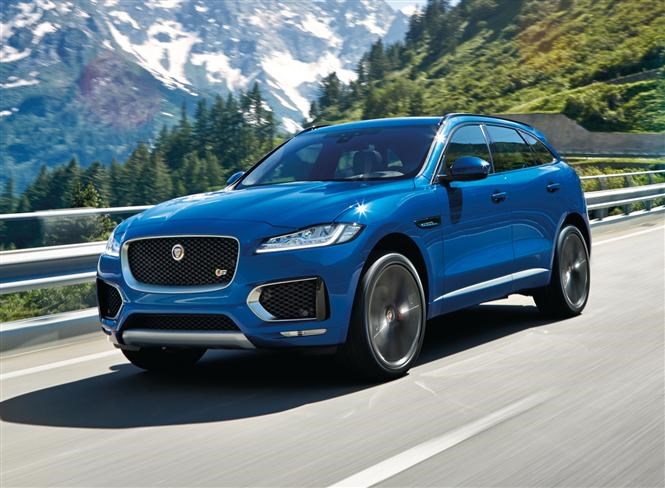The Jaguar F-Pace is literally new territory. The firm’s first ever SUV, it’s designed to deliver not only Jaguar’s trademark driving engagement, but also a high degree of off-road ability when the going gets rough.
A rival to the Porsche Macan, BMW X3 and Audi Q5, the jacked-up Jaguar can’t be as capable off-road as a Land Rover, of course – that would give the JLR product planners a headache – but in concept the F-Pace sounds a more realistic proposition for most SUV owners: better to drive on-road than its muddy-booted brethren, more than enough off-road smarts for the vast majority of us.
Capable off-road but no Land Rover
Off-road tech includes Land Rover-derived Adaptive Surface Response, which adjusts drivetrain settings to the terrain (though here it’s all automatic, not driver-selectable) and All-Surface Progress Control, a low-speed kind of cruise control so you can keep a constant throttle and concentrate on steering over tricky terrain.
We’re trying the F-Pace in a mix of off-road environments, but it’s the fast gravel roads that’ll give us the greatest idea of how it’ll feel on the road.
But this is not a Jaguar based on a Land Rover platform. Instead, it’s the third vehicle – after XE and XF – to use Jaguar’s all-new aluminium-intensive architecture. Eighty percent of the structure is aluminium, while steel doors and a composite tailgate feed into the material mix.
Measuring 4,721mm long, the F-Pace slots neatly between the XE (4,672mm) and XF (4,954mm) saloons.
Engine range includes a fleet focus
A range of four- and six-cylinder petrol and diesel engines are available. At launch, the highest performers are the supercharged 3-litre V6 (375bhp, 31.7mpg, 209g/km of CO2 output) familiar from the F-type, and the 3-litre turbodiesel V6 (296bhp, 47.1mpg, 159g/km) that we’re driving.
Available only in S specification – aside from the highly limited First Edition turbodiesel – both six-cylinder models cost £51,450. That compares favourably with the Porsches: £45,942 for the Macan Diesel S (258bhp, 46.3mpg, 159g/km), or £50,441 for the Cayenne Diesel (262bhp, 42.8mpg, 173g/km).
Jaguar is aggressively pursuing fleet sales too. Its new UK-built Ingenium 2-litre turbodiesel offers respectable 178bhp performance, but it’s the economy that catches the eye: Jaguar claims up to 57.7mpg and 129g/km so benefit-in-kind tax should stay appreciably low.
Entry-level rear-wheel drive variants with manual gearboxes are also available. Specified in this bare-bones trim, the F-Pace costs £34,170. Later, a 2-litre petrol will debut.
Fleet buyers will doubtless choose smaller wheel sizes, but the full range stretches through 18, 19, 20 and 22-inch designs, with summer/all-season/winter tyres offered on all but the 22s, which receive summer rubber only. The 22s look in proportion to the body rather than appearing humungous, so 18s will probably look ridiculously small.
Impressive cabin
Climbing behind the wheel quickly sets the scene for a sporty drive: you do get a commanding view of the road, but the driver’s seat also feels commendably low-set in the cabin, and the XE steering wheel looks small and wieldy in this context.
The seats are comfortable, the materials of good quality, the layout of the controls and operation of the touchscreen infotainment system mostly intuitive – having to look down to switch driving modes gets a black mark – but there’s no doubt that Range Rover interiors have a more assured swagger.
Nonetheless, this remains an impressively practical interior. It feels spacious and airy up front, and that feeling continues in row two. Jaguar has borrowed a trick from Land Rover, raising the rear seats by 10mm compared with the fronts but it seems to have paid dividends: there’s no claustrophobia in the back, and still there’s leg- and headroom for those well over six-feet-tall.
F-Pace is usefully versatile
The rear seats offer a 40/20/40 split, and fold flat to offer up to 1,740 litres of space. Even with five passengers aboard, you’ve still got 650 litres of luggage space; the larger Cayenne Diesel offers 618 litres.
Jaguar has spent more time than ever making the F-Pace as versatile as possible, hence there are deep storage bins, a reversible boot floor – carpeted one side, rubberised the other – an optional gesture tailgate, and even an ‘Activity Key’. The latter feature allows you to leave the keys in the car when kite surfing or doing other vigorous outdoors things, then touch a wristband to the ‘J’ on the Jaguar tailgate badge to unlock the car.
Driving the 3-litre V6 diesel
The F-Pace impresses with its balance of immediacy and comfort. Its steering is quite firm by Jaguar standards, but it’s quick and has no dead spots, so every little input makes a difference; it’s a precision that’s matched by the other controls, including a responsive throttle and quick but slick automatic gear changes.
Jaguars usually ride and handle very well, and the F-Pace appears to be no exception. Our car rode on 22-inch alloys and adaptive dampers (standard on S models), and its combination of sure-footed grip, agility and composure enable fluster-free cross-country travel, while the cabin seemed impressively refined at a fast cruise during our brief on-road passenger ride.
The 3-litre turbodiesel perfectly suited the F-Pace’s character: responsive, easygoing, even quite tuneful as diesels go, it gives the F-Pace an effortless flexibility and more than enough oomph to make rapid progress.
Verdict
Judging by our run up and down a fast gravel track, the F-Pace should be a contender for the best driver’s SUV in its class. Not only that, it also feels significantly better to drive than the last-generation XF Sportbrake it effectively replaces in today’s Jaguar line-up.
Factor in its practicality, stylish exterior design, strong performance for six-cylinder models and excellent efficiency for four cylinders and it’s an incredibly appealing package.
To read our full review on the Jaguar F-Pace, click here





